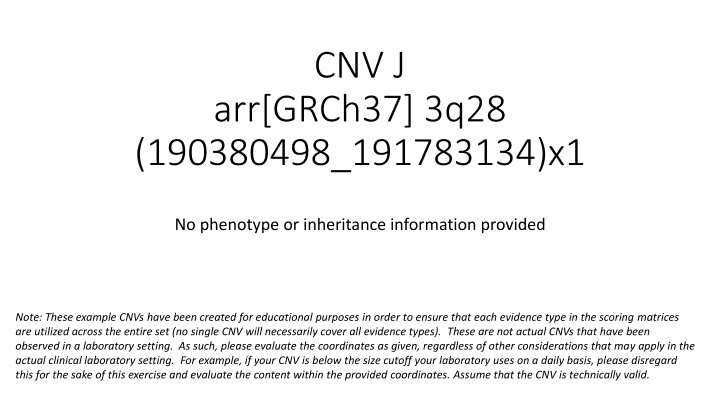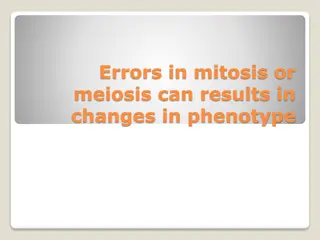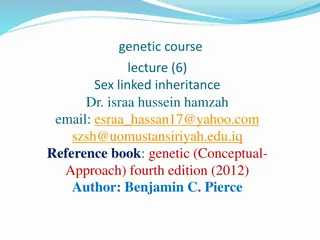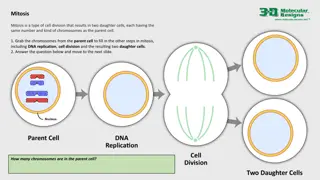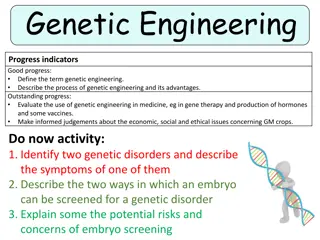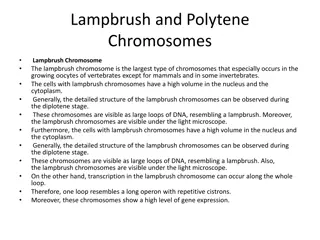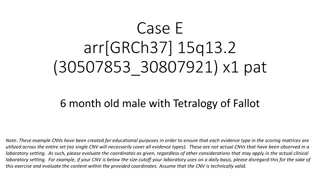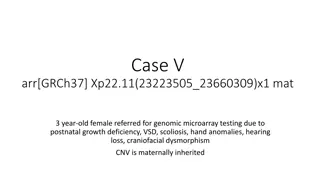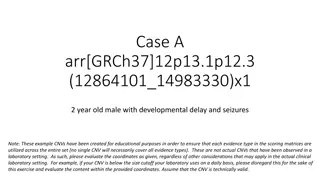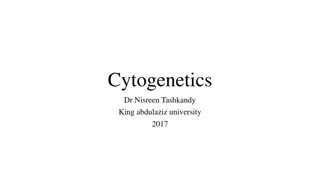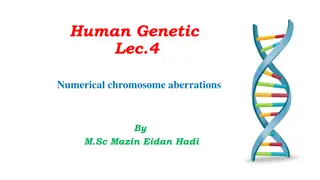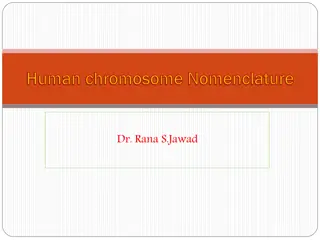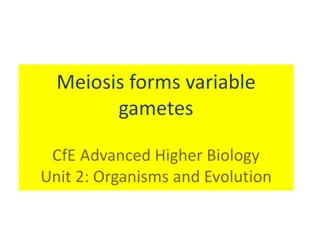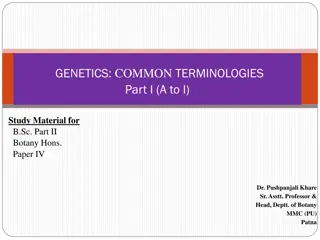Genetic Assessment of CNV.J on Chromosome 3q28 - Case Study J
This case study evaluates a copy number variant (CNV) on chromosome 3q28 (190380498_191783134) associated with a loss of genetic material. The assessment includes genomic content analysis, gene involvement categorization, evaluation of established/predicted genes, and detailed scrutiny of the CCDC50 gene for evidence of haploinsufficiency. Limited evidence is found to support the relationship between CCDC50 and hearing loss. For further information, refer to the provided clinical data and images.
Download Presentation

Please find below an Image/Link to download the presentation.
The content on the website is provided AS IS for your information and personal use only. It may not be sold, licensed, or shared on other websites without obtaining consent from the author.If you encounter any issues during the download, it is possible that the publisher has removed the file from their server.
You are allowed to download the files provided on this website for personal or commercial use, subject to the condition that they are used lawfully. All files are the property of their respective owners.
The content on the website is provided AS IS for your information and personal use only. It may not be sold, licensed, or shared on other websites without obtaining consent from the author.
E N D
Presentation Transcript
CNV J arr[GRCh37] 3q28 (190380498_191783134)x1 No phenotype or inheritance information provided Note: These example CNVs have been created for educational purposes in order to ensure that each evidence type in the scoring matrices are utilized across the entire set (no single CNV will necessarily cover all evidence types). These are not actual CNVs that have been observed in a laboratory setting. As such, please evaluate the coordinates as given, regardless of other considerations that may apply in the actual clinical laboratory setting. For example, if your CNV is below the size cutoff your laboratory uses on a daily basis, please disregard this for the sake of this exercise and evaluate the content within the provided coordinates. Assume that the CNV is technically valid.
Clinical Information arr[GRCh37] 3q28(190380498_191783134)x1 No phenotype or inheritance information provided Use the LOSS scoring metric
Section 1: Initial Assessment of Genomic Content Case J Genes Involved Would apply category 1A (contains protein-coding or other known functionally important elements), as this deletion includes several protein-coding genes. 0 points; continue evaluation Total: 0 points
Section 2: Overlap with Established/Predicted HI or Established Benign Genes/Genomic Regions Case J Does not include any established P or B genes/genomic regions Total: 0 points
2H: Does CNV J include any predicted HI genes? NO Total: 0 points
Section 3: Evaluation of Gene Number 5 protein- coding genes (Category 3A: 0 points) Total: 0 points
Section 4: Detailed Evaluation of Genomic Content Where to begin? CCDC50 is the only OMIM Morbid gene in the region suggest starting here Assess this gene for evidence of haploinsufficiency
CCDC50 The ClinGen Hearing Loss gene curation expert panel feels that there is limited evidence to support this gene-disease relationship. Click View Report to see what literature is cited. OMIM reports that this gene is associated with AD hearing loss, but the ? in front of the phenotype indicates that this association is provisional.
Is loss of function a plausible mechanism for disease for this gene? The pLI for this gene is 0, with a LOEUF score of 0.49. The upper bound of the 95% confidence interval is 0.74, well above the recommended cutoff (recommended by gnomAD) of <0.35. This information suggests that LOF variants are well tolerated in the general population. However, hearing loss (HL) is not a phenotype expected to impact reproductive fitness. This makes it difficult to assess the potential pathogenicity of the LOF variants identified in this gene in individuals with HL. Are they true causes of HL, or are they red herrings?
Modamio-Hoybjor et al. 2007 (PMID:17503326) Describes a Spanish family with progressive, postlingual, nonsyndromic hearing loss 18 affected individuals over 4 generations Linkage studies previously implicated a 3cM locus at 3q28q29 for this family Sequence analysis excluded other genes in the interval: CLDN16, FGF12, and IL1RAP Sequencing of CCDC50 demonstrated a heterozygous, 8bp tandem duplication leading to a frameshift that replaces the last 15aa of the protein with a novel 36aa sequence NM_178335:c.1394_1401dupCACGGCAT (p.Phe486HisfsX37) Variant occurs within the last 50bp of the penultimate exon not expected to undergo nonsense mediated decay (NMD) Variant is said to segregate in family, but the authors did not specify who in the family was tested. No points awarded unclear if this variant is resulting in LOF Total: 0 points
Iwasa et al. 2016 (PMID:27911912) Describes variants identified using a tiered screening approach in a cohort of 75 Japanese patients with autosomal dominant sensorineural hearing loss Individuals tested for variants in a number of hearing loss genes; no genome-wide analysis performed A single individual was noted to have a nonsense variant in CCDC50 NM_178335:c.820C>T (p.R274X) No phenotype information, no inheritance information Variant is present in gnomAD No points awarded variant with no inheritance information, non-specific phenotype This variant falls in an exon that does not exhibit a pattern of conservation typical of a protein-coding exon. Total: 0 points
Sommen et al. 2016 (PMID: 27068579) Describes a cohort of 131 presumed AR nonsyndromic HL patients of Western- European ethnicity All patients parents are said to have normal hearing Prior negative GJB2 testing (combination of Sanger sequencing and screening for c.35delG unclear which patients had which testing) Targeted sequencing of 79 genes, including genes thought to be associated with AR, AD, and X-linked HL; syndromic and nonsyndromic forms NM_178335.2:c.777_778insTAAT (p.His260Ter) identified in a single individual No phenotype or inheritance information available No indication of whether or not this variant was heterozygous (the cohort was selected for presumed AR inheritance), or if other variants were identified in this individual Variant not present in gnomAD as of May 2020 The exon in which this variant occurs may be alternatively spliced. No points awarded variant with no inheritance information, non-specific phenotype Total: 0 points
Population Data Check While there are numerous smaller deletions within the DGV Gold Standard dataset, none are similar in genomic content to CNV J. None seem to overlap CCDC50. Total: 0 points
Population Data Check Large, 68Mb inversion observed once (our CNV is ~1.4 Mb) Deletion involving all of CCDC50 observed only once, not frequent enough to call this Benign Total: 0 points
Section 5: Evaluation of Inheritance Pattern/Family History for Patient Being Studied We are provided no phenotypic or inheritance information for our patient. We must use category 5F (inheritance information unavailable or uninformative) 0 points Total: 0 points
Conclusion Classification: Variant of Uncertain Significance It is unclear whether loss of CCDC50 results in an autosomal dominant hearing loss phenotype. More information is needed. What if we weren t so conservative? What if we counted each of the observed cases? It wouldn t matter! Even if we awarded 0.45 points for the segregation in the first family, 0.10 (x2) points for the variants with unknown inheritance in the second and third individuals, we would STILL have a classification of VUS. There simply isn t enough information available at this time.
